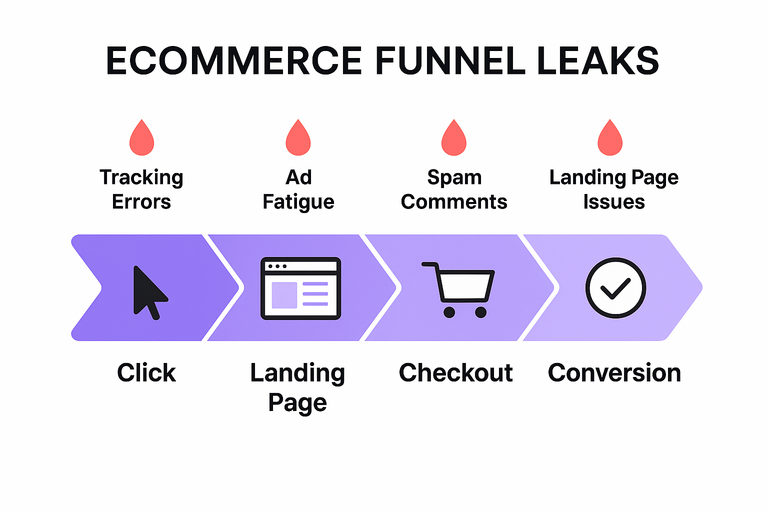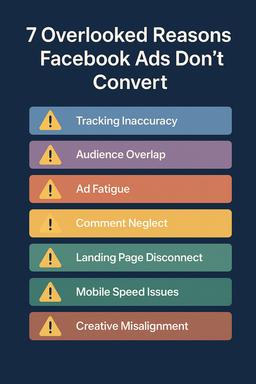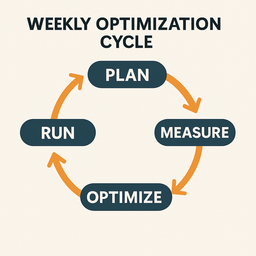December 4, 2025
A data-backed breakdown of the real comment patterns driving ad performance in 2025.
Aug 27, 2025
10 Mins
Struggling with Facebook ads not converting? Discover 7 overlooked reasons — from tracking errors to ad fatigue to comment sections — and learn how to fix them to protect ROAS.

You’ve invested time, creative energy, and serious budget into Facebook ads. The targeting is live, the campaign manager says “active,” impressions are flowing — but conversions? Crickets.
If this sounds familiar, you’re not alone. Many ecommerce founders face the same painful question: why are my Facebook ads not converting?
Most blogs repeat the obvious: bad targeting, weak creative, or not enough budget. But the truth is more nuanced. In this article, we’ll cover seven overlooked reasons your ads might be failing — and more importantly, how to fix them. From tracking glitches to comment sections that quietly kill your ROAS, we’ll unpack what’s really happening behind the scenes.
Let’s dive in.

If your Facebook Pixel or Conversions API (CAPI) isn’t firing correctly, your data is already broken. This means Meta can’t optimize your ads toward real conversions, and you can’t trust the numbers in Ads Manager.
When Meta doesn’t get clean signals, it optimizes against the wrong events. You might be paying for “Add to Cart” actions that never become sales — and Meta thinks the campaign is “working.”
You’ve got a killer creative that was converting last week… then overnight, it tanks. CTR drops, CPA climbs, and your “winner” looks dead.
This is ad fatigue. Audiences see your ad too often, engagement falls, and Meta reduces delivery efficiency.
Reddit threads are full of founders saying: “Spent $400+ on ads, no sales — can’t figure out why.” Often, it’s not targeting, but fatigue.
Even if your creative is solid, showing it to the wrong people guarantees no sales. Many founders go too broad (wasting spend) or too narrow (starving delivery).
Even if targeting and tracking are perfect, bad creative kills performance. A blurry product photo or a generic “Shop Now” callout won’t resonate.
Meta’s algorithm rewards ads with high engagement. If nobody clicks, costs rise.
Your ad can crush it, but if your landing page doesn’t seal the deal, you’ll never see conversions.
Too many founders launch ads, check back after two weeks, and wonder why nothing converted. By then, hundreds (or thousands) of dollars may be gone.
Facebook ads need weekly optimization, not monthly reviews. Metrics can swing fast, and you need to catch them early.
Even if your ad drives interest, buyers often need reassurance. And sometimes, it’s the comment section under your ad that determines trust.
Prospects read comments to gauge legitimacy. If they see spam, trolls, or unanswered questions like “Does this ship to Canada?”, they bounce.

If your Facebook ads aren’t converting, the problem is rarely one thing. More often, it’s a combination of leaks across the funnel — from bad tracking to fatigued creatives to neglected comments.
The good news? Each of these issues is fixable. Start by auditing your pixel, rotate creatives regularly, refine your targeting, and ensure your landing page delivers on your ad’s promise. Don’t just analyze once a month — make optimization part of your weekly rhythm.
Finally, don’t ignore the comment section. It’s where buyers decide if you’re credible. Tools like Superpower give you the ability to moderate spam, trolls, and competitor plugs in real time, protecting your ROAS while you focus on scaling.
Ecommerce growth isn’t about throwing more budget at broken ads. It’s about plugging leaks, building trust, and creating a funnel where every click has the chance to convert.

Q1: Why do my Facebook ads get clicks but no sales?
Usually due to a landing page mismatch, poor tracking, or missing trust signals.
Q2: How often should I refresh creatives to avoid fatigue?
Every 7–14 days if you’re scaling; sooner if frequency >3.
Q3: Can spam comments really hurt conversions?
Yes. They erode trust, reduce CTR, and signal low-quality engagement to Meta’s algorithm.
Q4: How do I know if my pixel is set up correctly?
Use Meta Pixel Helper and Events Manager’s Test Events tool.
Q5: Should I pause ads that aren’t converting right away?
Not immediately. Give 3–5 days for data, then kill underperformers.

Explore expert tips, industry trends, and actionable strategies to help you grow, and succeed. Stay informed with our latest updates.